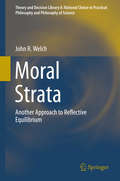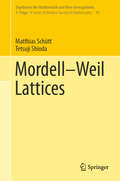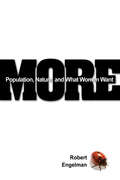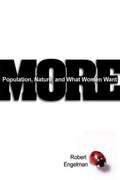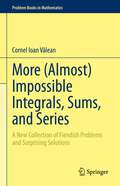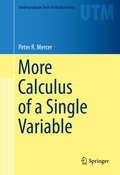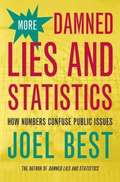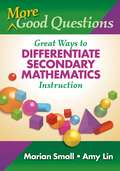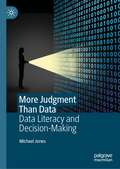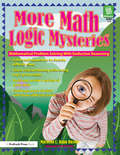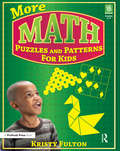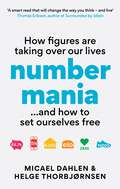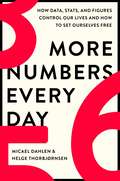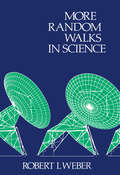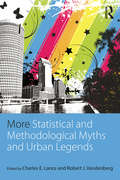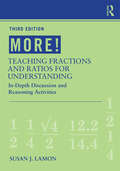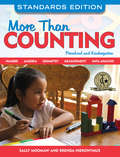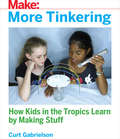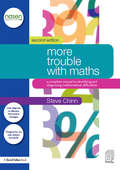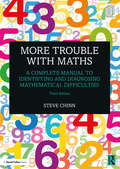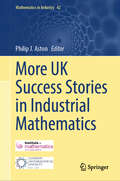- Table View
- List View
Moral Strata
by John R. WelchThis volume recreates the received notion of reflective equilibrium. It reconfigures reflective equilibrium as both a cognitive ideal and a method for approximating this ideal. The ideal of reflective equilibrium is restructured using the concept of discursive strata, which are formed by sentences and differentiated by function. Sentences that perform the same kind of linguistic function constitute a stratum. The book shows how moral discourse can be analyzed into phenomenal, instrumental, and teleological strata, and the ideal of reflective equilibrium reworked in these terms. In addition, the work strengthens the method of reflective equilibrium by harnessing the resources of decision theory and inductive logic. It launches a comparative version of decision theory and employs this framework as a guide to moral theory choice. It also recruits quantitative inductive logic to inform a standard of inductive cogency. When used in tandem with comparative decision theory, this standard can aid in the effort to turn the undesirable condition of reflective disequilibrium into reflective equilibrium.
Mordell–Weil Lattices (Ergebnisse der Mathematik und ihrer Grenzgebiete. 3. Folge / A Series of Modern Surveys in Mathematics #70)
by Matthias Schütt Tetsuji ShiodaThis book lays out the theory of Mordell–Weil lattices, a very powerful and influential tool at the crossroads of algebraic geometry and number theory, which offers many fruitful connections to other areas of mathematics. The book presents all the ingredients entering into the theory of Mordell–Weil lattices in detail, notably, relevant portions of lattice theory, elliptic curves, and algebraic surfaces. After defining Mordell–Weil lattices, the authors provide several applications in depth. They start with the classification of rational elliptic surfaces. Then a useful connection with Galois representations is discussed. By developing the notion of excellent families, the authors are able to design many Galois representations with given Galois groups such as the Weyl groups of E6, E7 and E8. They also explain a connection to the classical topic of the 27 lines on a cubic surface.Two chapters deal with elliptic K3 surfaces, a pulsating area of recent research activity which highlights many central properties of Mordell–Weil lattices. Finally, the book turns to the rank problem—one of the key motivations for the introduction of Mordell–Weil lattices. The authors present the state of the art of the rank problem for elliptic curves both over Q and over C(t) and work out applications to the sphere packing problem. Throughout, the book includes many instructive examples illustrating the theory.
More: Population, Nature, and What Women Want
by Robert EngelmanIn the capital of Ghana, a teenager nicknamed "Condom Sister" trolls the streets to educate other young people about contraception. Her work and her own aspirations point to a remarkable shift not only in the West African nation, where just a few decades ago women had nearly seven children on average, but around the globe. While world population continues to grow, family size keeps dropping in countries as diverse as Switzerland and South Africa. The phenomenon has some lamenting the imminent extinction of humanity, while others warn that our numbers will soon outgrow the planet's resources. Robert Engelman offers a decidedly different vision--one that celebrates women's widespread desire for smaller families. Mothers aren't seeking more children, he argues, but more for their children. If they're able to realize their intentions, we just might suffer less climate change, hunger, and disease, not to mention sky-high housing costs and infuriating traffic jams. In More, Engelman shows that this three-way dance between population, women's autonomy, and the natural world is as old as humanity itself. He traces pivotal developments in our history that set population--and society--on its current trajectory, from hominids' first steps on two feet to the persecution of "witches" in Europe to the creation of modern contraception. Both personal and sweeping, More explores how population growth has shaped modern civilization--and humanity as we know it. The result is a mind-stretching exploration of parenthood, sex, and culture through the ages. Yet for all its fascinating historical detail, More is primarily about the choices we face today. Whether society supports women to have children when and only when they choose to will not only shape their lives, but the world all our children will inherit.
More: Population, Nature and What Women Want
by Robert EngelmanIn the capital of Ghana, a teenager nicknamed "Condom Sister" trolls the streets to educate other young people about contraception. Her work and her own aspirations point to a remarkable shift not only in the West African nation, where just a few decades ago women had nearly seven children on average, but around the globe. While world population continues to grow, family size keeps dropping in countries as diverse as Switzerland and South Africa. The phenomenon has some lamenting the imminent extinction of humanity, while others warn that our numbers will soon outgrow the planet's resources. Robert Engelman offers a decidedly different vision--one that celebrates womens' widespread desire for smaller families. Mothers aren't seeking more children, he argues, but more for their children. If they're able to realize their intentions, we just might suffer less climate change, hunger, and disease, not to mention sky-high housing costs and infuriating traffic jams. In More, Engelman shows that this three-way dance between population, womens' autonomy, and the natural world is as old as humanity itself. He traces pivotal developments in our history that set population--and society--on its current trajectory, from hominids' first steps on two feet to the persecution of 'witches' in Europe to the creation of modern contraception. Both personal and sweeping, More explores how population growth has shaped modern civilization --and humanity as we know it. The result is a mind-stretching exploration of parenthood, sex, and culture through the ages. Yet for all its fascinating historical detail, More is primarily about the choices we face today. Whether society supports women to have children when and only when they choose to will not only shape their lives, but the world all our children will inherit.
More: A New Collection of Fiendish Problems and Surprising Solutions (Problem Books in Mathematics)
by Cornel Ioan VăleanThis book, the much-anticipated sequel to (Almost) Impossible, Integrals, Sums, and Series, presents a whole new collection of challenging problems and solutions that are not commonly found in classical textbooks. As in the author’s previous book, these fascinating mathematical problems are shown in new and engaging ways, and illustrate the connections between integrals, sums, and series, many of which involve zeta functions, harmonic series, polylogarithms, and various other special functions and constants. Throughout the book, the reader will find both classical and new problems, with numerous original problems and solutions coming from the personal research of the author. Classical problems are shown in a fresh light, with new, surprising or unconventional ways of obtaining the desired results devised by the author. This book is accessible to readers with a good knowledge of calculus, from undergraduate students to researchers. It will appeal to all mathematical puzzlers who love a good integral or series and aren’t afraid of a challenge.
More Calculus of a Single Variable
by Peter R. MercerThis book goes beyond the basics of a first course in calculus to reveal the power and richness of the subject. Standard topics from calculus -- such as the real numbers, differentiation and integration, mean value theorems, the exponential function -- are reviewed and elucidated before digging into a deeper exploration of theory and applications, such as the AGM inequality, convexity, the art of integration, and explicit formulas for π. Further topics and examples are introduced through a plethora of exercises that both challenge and delight the reader. While the reader is thereby exposed to the many threads of calculus, the coherence of the subject is preserved throughout by an emphasis on patterns of development, of proof and argumentation, and of generalization. More Calculus of a Single Variable is suitable as a text for a course in advanced calculus, as a supplementary text for courses in analysis, and for self-study by students, instructors, and, indeed, all connoisseurs of ingenious calculations.
More Damned Lies and Statistics: How Numbers Confuse Public Issues
by Joel BestIn this sequel to the acclaimed "Damned Lies and Statistics," which the Boston Globe said "deserves a place next to the dictionary on every school, media, and home-office desk," Joel Best continues his straightforward, lively, and humorous account of how statistics are produced, used, and misused by everyone from researchers to journalists. Underlining the importance of critical thinking in all matters numerical, Best illustrates his points with examples of good and bad statistics about such contemporary concerns as school shootings, fatal hospital errors, bullying, teen suicides, deaths at the World Trade Center, college ratings, the risks of divorce, racial profiling, and fatalities caused by falling coconuts. "More Damned Lies and Statistics" encourages all of us to think in a more sophisticated and skeptical manner about how statistics are used to promote causes, create fear, and advance particular points of view. Best identifies different sorts of numbers that shape how we think about public issues: missing numbers are relevant but overlooked ;confusing numbers bewilder when they should inform; scary numbers play to our fears about the present and the future; authoritative numbers demand respect they don't deserve; magical numbers promise unrealistic, simple solutions to complex problems; and contentious numbers become the focus of data duels and stat wars. The author's use of pertinent, socially important examples documents the life-altering consequences of understanding or misunderstanding statistical information. He demystifies statistical measures by explaining in straightforward prose how decisions are made about what to count and what not to count, what assumptions get made, and which figures are brought to our attention. Best identifies different sorts of numbers that shape how we think about public issues. Entertaining, enlightening, and very timely, this book offers a basis for critical thinking about the numbers we encounter and a reminder that when it comes to the news, people count-- in more ways than one.
More Fewer Less
by Tana HobanPhotographs illustrate groupings of objects in larger and smaller numbers.
More Good Questions: Great Ways to Differentiate Secondary Mathematics Instruction
by Marian Small Amy LinMore Good Questions, written specifically for secondary mathematics teachers, presents two powerful and universal strategies that teachers can use to differentiate instruction across all math content: Open Questions and Parallel Tasks. Showing teachers how to get started and become expert with these strategies, this book also demonstrates how to use more inclusive learning conversations to promote broader student participation.
More Judgment Than Data: Data Literacy and Decision-Making
by Michael JonesMore data has been produced in the 21st century than all of human history combined. Yet, are we making better decisions today than in the past? How many poor decisions result from the absence of data? The existence of an overwhelming amount of data has affected how we make decisions, but it has not necessarily improved how we make decisions. To make better decisions, people need good judgment based on data literacy—the ability to extract meaning from data. Including data in the decision-making process can bring considerable clarity in answering our questions. Nevertheless, human beings can become distracted, overwhelmed, and even confused in the presence of too much data. The book presents cautionary tales of what can happen when too much attention is spent on acquiring more data instead of understanding how to best use the data we already have. Data is not produced in a vacuum, and individuals who possess data literacy will understand the environment and incentives in the data-generating process. Readers of this book will learn what questions to ask, what data to pay attention to, and what pitfalls to avoid in order to make better decisions. They will also be less vulnerable to those who manipulate data for misleading purposes.
More Math Games & Activities from Around the World
by Claudia ZaslavskyMath, history, art, and world cultures come together in this delightful book for kids, even for those who find traditional math lessons boring. More than 70 games, puzzles, and projects encourage kids to hone their math skills as they calculate, measure, and solve problems. The games span the globe, and many have been played for thousands of years, such as three-in-a-row games like Achi from Ghana or the forbidden game of Jirig from Mongolia. Also included are imaginative board games like Lambs and Tigers from India and the Little Goat Game from Sudan, or bead and string puzzles from China, and M+bius strip puzzles from Germany. Through compelling math play, children will gain confidence and have fun as they learn about the different ways people around the world measure, count, and use patterns and symmetry in their everyday lives.
More Math Logic Mysteries: Grades 5-8
by Marilynn L. Rapp BuxtonStudents love trying to solve challenging puzzles. So, why not build and review their math skills while they're having fun? More Math Logic Mysteries, the sequel to the best-selling Math Logic Mysteries, requires students to complete math problems and use deductive reasoning to unlock the clues needed to solve matrix-based logic problems.Mathematical skills covered include measurement, number operations, geometry, probability, fractions, decimals, percentages, and algebra. The puzzles range from simple introductions to matrix-based problems, to more difficult puzzles that cover advanced math topics. Each reproducible puzzle is based on an enjoyable story your students will love as they attempt to solve problems and crack the mysteries.This book includes a detailed how-to section for teaching logic puzzles and an in-depth answer key, so students can understand the thinking process behind each solution. After doing these fun and challenging puzzles, your students will ask for even More Math Logic Mysteries!Grades 5-8
More Math Puzzles and Patterns for Kids: Grades 2-4
by Kristy FultonMove beyond the norm in your math classroom and challenge students to think critically with More Math Puzzles and Patterns for Kids, a new companion book to the popular Math Puzzles and Patterns for Kids. This book contains more of students' favorite puzzles and patterns, as well as a few new ones for students to explore. All of the mathematical activities in this book were chosen for their important role in mathematics' history. Like its predecessor, this book explores the hottest concepts in puzzle solving—math logic puzzles—while teaching students how to use reasoning to solve some of math's biggest conundrums: real-life patterns and puzzles such as Fibonacci's sequence, Sudoku puzzles, tangrams, Pascal's triangle, and magic squares. Students will sharpen their math skills while they learn the basic premises behind each challenging puzzle and then use the skills they have learned to solve multiple versions of each puzzle. Grades 2-4
More. Numbers. Every. Day.: How Figures Are Taking Over Our Lives – And Why It's Time to Set Ourselves Free
by Micael Dahlen Helge ThorbjørnsenHow many steps have you done today?How many emails answered?How much money have you spent this week And how many hours have you slept?Welcome to the numberdemic, where a deluge of figures, stats and data manipulate your every move. From the way you work, date and exercise to the products you buy and the news you read, numbers have worked their way into every part of our lives. But is life better this way? How are all of those numbers affecting us?With fascinating, sometimes frightening and sometimes shrewdly funny research, behavioural economists Micael Dahlen and Helge Thorbjørnsen explain why we're so attached to numbers and how we can free ourselves from their tyranny. Along the way, you'll learn why viral videos, however inaccurate, become more convincing with every view; how numbers can affect the way we physically age, if we let them; why the more films you rate the less impressive you'll find them and how numbers that 'anchor' themselves in your brain can affect the size of your mortgage - plus much more.Sharp, insightful and totally engaging, MORE. NUMBERS. EVERY. DAY. is your vaccination against a world obsessed with numbers.'An entertaining and thought-provoking antidote to the tyranny of numbers in the modern world. By looking at the psychology of how we are tricked, goaded and often crushed by endless quantification, the authors present a winning case for weaning ourselves off number-dependence.'-Alex Bellos, author of Can You Solve My Problems?'Everybody should read this book. A smart and insightful read that will totally change the way you think - and live.'-Thomas Erikson, author of Sunday Times bestseller Surrounded By Idiots'Written in lucid, skillfully translated prose that puts the science into philosophical perspective, this shines a fascinating light on the modern-day obsession with numerical quantity over quality.' -Publishers Weekly'In 31,234 words Dahlen and Thorbjørnsen cast their four critical, and at times whimsical, eyes at our numbered existences revealing that consuming too much 'pi' might be bad for our health.'-Professor Scott Page, author of The Model Thinker
More Numbers Every Day: How Data, Stats, and Figures Control Our Lives and How to Set Ourselves Free
by Micael Dahlen Helge ThorbjørnsenYour personal number detox: learn how numbers have taken control of your life—and how to get it back. How many hours of sleep did you get last week? How many steps did you walk today? How many friends do you have? It seems everywhere you go, you&’re surrounded by numbers. You depend on them, so you think they&’re dependable, neutral, exact. But the truth? Numbers lie. They mislead. They&’re tricky, little manipulative devils. And they&’re in the process of really messing things up for you. You just don&’t know it yet. Today we all strive to quantify everything: calories, likes, website traffic, and even friends. We measure ourselves against others and compare our real experiences to imagined averages. But in our rush to measure, we can lose sight of what matters. From internationally renowned economics professors Micael Dahlen and Helge Thorbjørnsen, More Numbers Every Day is a timely and powerful investigation—and warning—about the trouble numbers can bring us. With groundbreaking, empowering, sometimes frightening, and sometimes funny research, they describe how numbers creep into our heads and bodies, affecting how we think and feel. But numbers aren&’t all bad. Sometimes they make us weaker, but sometimes they also make us stronger. More Numbers Every Day is more than just an exploration in to the somewhat mysterious, seemingly infinite pandemic of numbers. It&’s a numerical vaccination—for a happier and more integrally healthy life.
More Or Less
by Stuart J. MurphyIs your age more than 5? Is it less than 10? Eddie's got to guess. And he doesn't want to be wrong! Eddie has a booth at the school fair, guessing people's ages. He hasn't guessed wrong yet, but if he does, he gets dunked. Can Eddie keep guessing right -- and keep from getting wet? Comparing whole numbers and understanding what's more and what's less are a big part of Eddie's strategy, and an important math skill for young readers to learn.
More Random Walks in Science
by R.L. WeberMore Random Walks in Science is an anthology of fascinating and frequently amusing anecdotes, quotations, illustrations, articles, and reviews that reflect the more lighthearted aspects of the scientific world and the less serious excursions of the scientific mind. The book is guaranteed to delight anyone who has a professional or amateur interest in science.
More Statistical and Methodological Myths and Urban Legends: Doctrine, Verity and Fable in Organizational and Social Sciences
by Charles E. Lance Robert J. VandenbergThis book provides an up-to-date review of commonly undertaken methodological and statistical practices that are based partially in sound scientific rationale and partially in unfounded lore. Some examples of these “methodological urban legends” are characterized by manuscript critiques such as: (a) “your self-report measures suffer from common method bias”; (b) “your item-to-subject ratios are too low”; (c) “you can’t generalize these findings to the real world”; or (d) “your effect sizes are too low.” What do these critiques mean, and what is their historical basis? More Statistical and Methodological Myths and Urban Legends catalogs several of these quirky practices and outlines proper research techniques. Topics covered include sample size requirements, missing data bias in correlation matrices, negative wording in survey research, and much more.
MORE! Teaching Fractions and Ratios for Understanding: In-Depth Discussion and Reasoning Activities
by Susan J. LamonMore is not an answer key but a resource that provides the scaffolding for the groundbreaking approach to fraction and ratio instruction presented in its companion text, Teaching Fractions and Ratios. Keeping the focus on the reasoning needed to properly understand and teach rational numbers, More shows teachers how to engage in powerful ways of thinking so that they can, in turn, enhance the mathematical education of their students. Like its companion text, More has been heavily expanded and reorganized, including even more student work, templates for key manipulatives, and an emphasis on applications to everyday life. Based on the content chapters in Teaching Fractions and Ratios, each chapter includes: In-depth Discussions of selected problems and their solutions. Supplementary Activities and a collection of challenging problems involving fractions. Praxis Preparation Questions geared to the content of each chapter.
More Than Counting
by Brenda Hieronymus Sally MoomawMake learning count with math activities and games for preschool and pre-kindergarten children that reflect early learning standards from the National Council of Teachers of Mathematics (NCTM). Combining new activities and favorites from the best-selling More Than Counting and Much More Than Counting by the same author team, this edition provides a total of 135 math lessons. Activities are organized by learning standard, which include number sense and operations, algebra, geometry, measurement and data analysis, and probability. Each activity includes a materials list, modifications for special needs, early learning standards connection, and common questions and answers.
More Than One
by Miriam SchleinA creative and colorful counting book for young readers demonstrates that one can actually be more than one, such as one pair of shoes is made up of two shoes and one week that is actually seven days.
More Tinkering: How Kids in the Tropics Learn by Making Stuff
by Curt GabrielsonTinkering is a way of learning through hands-on activity -- experimenting with materials and devices to see how they work, taking things apart, making small changes and improvements, exploring and inventing. Tinkering may seem like a form of play -- and it is -- but it is also a powerful way of discovering truths about science, engineering, and math. With this book, Curt Gabrielson follows up on his best-seller Tinkering: Kids Learn by Making Stuff with this all-new volume that features more than three dozen fun and educational tinkering projects based on his years of working with kids in the tropical island nation of Timor-Leste. Step-by-step instructions accompanied by full-color photos take you through a range of enjoyable projects that explore life sciences, physics, chemistry, earth sciences, and mathematics. You'll discover how math is used to make baskets, how fungi create fermentation, how electricity can make a magnet, how the greenhouse effect creates warming, and much more. The author also enlivens his latest batch of tinkering projects with colorful tales of his experiences in the tropic and the lives of the people he' s met there.Inside you'll find:Clear directions for making simple projects and doing activities that teach science, mathematics and engineeringProjects rooted in day to day life and experience in a small, developing nation in the Asian tropicsFull-color photographs throughoutExplicit connections to standard STEAM concepts, K-12Activities doable with less than $5 worth of common materialsThis book is perfect for parents, teachers, and students with an interest in hands-on, tinkering-based science and mathematics education, whether in traditional schools or in home-schooling situations. It will also be of interest to anyone who wants to learn more about developing nations, the culture and unique history of Timor-Leste, tropical nations or Asian cultures, with specific links to Indonesia, Portugal, or Australia.
More Trouble with Maths: A Complete Manual to Identifying and Diagnosing Mathematical Difficulties (nasen spotlight)
by Steve ChinnMore Trouble with Maths acknowledges that there are many reasons why children and adults are unable to function mathematically. Difficulties include problems with rote learning basic facts and procedures, debilitating anxiety, poor working and short-term memories and mathematics vocabulary. Central to this new edition is a range of standardised tests and diagnostic activities, including a 15 minute test of basic mathematics, a thinking style test, tests of basic fact retrieval and maths anxiety. Guiding the reader in the interpretation of tests, this new edition shows how identifying the barriers to learning is the first step in a programme of intervention. Written in an engaging and user-friendly style, Steve Chinn draws on his extensive experience and expertise to: show how to consider and appraise the many factors relating to mathematical learning difficulties explain how these factors can be investigated explore their impact on learning mathematics. Emphasising the need for a clinical approach when assessing individuals, this book shows how diagnosis and assessment can become integrated into everyday teaching. This highly practical and relevant resource is a crucial resource for anyone who wants to accurately and effectively identify the depth and nature of mathematical learning difficulties and dyscalculia.
More Trouble with Maths: A Complete Manual to Identifying and Diagnosing Mathematical Difficulties (David Fulton / Nasen Ser.)
by Steve ChinnNow in an updated third edition, this invaluable resource takes a practical and accessible approach to identifying and diagnosing many of the factors that contribute to mathematical learning difficulties and dyscalculia. Using a combination of formative and summative approaches, it provides a range of norm-referenced, standardised tests and diagnostic activities, each designed to reveal common error patterns and misconceptions in order to form a basis for intervention. Revised to reflect developments in the understanding of learning difficulties in mathematics, the book gives a diagnostic overview of a range of challenges to mathematical learning, including difficulties in grasping and retaining facts, problems with mathematics vocabulary and maths anxiety. Key features of this book include: Photocopiable tests and activities designed to be presented in a low-stress way Guidance on the interpretation of data, allowing diagnosis and assessment to become integrated into everyday teaching Sample reports, showing the diagnostic tests in practice Drawing on tried and tested methods, as well as the author’s extensive experience and expertise, this book is written in an engaging and user-friendly style. It is a vital resource for anyone who wants to accurately identify the depth and nature of mathematical learning difficulties and dyscalculia.
More UK Success Stories in Industrial Mathematics (Mathematics in Industry #42)
by Philip J. AstonThis volume highlights successful projects in which academic mathematicians in the United Kingdom got involved with solving problems in industry for which mathematics was essential. It contains a wide range of articles in areas ranging from music composition to climate change which describe successful collaborations between mathematicians / statisticians and industry. The impact that the work had on the companies involved and on people’s everyday lives is included in each article. The book conveys to the non-expert some of the many ways that mathematics and statistics have contributed to economic growth and societal well-being.
